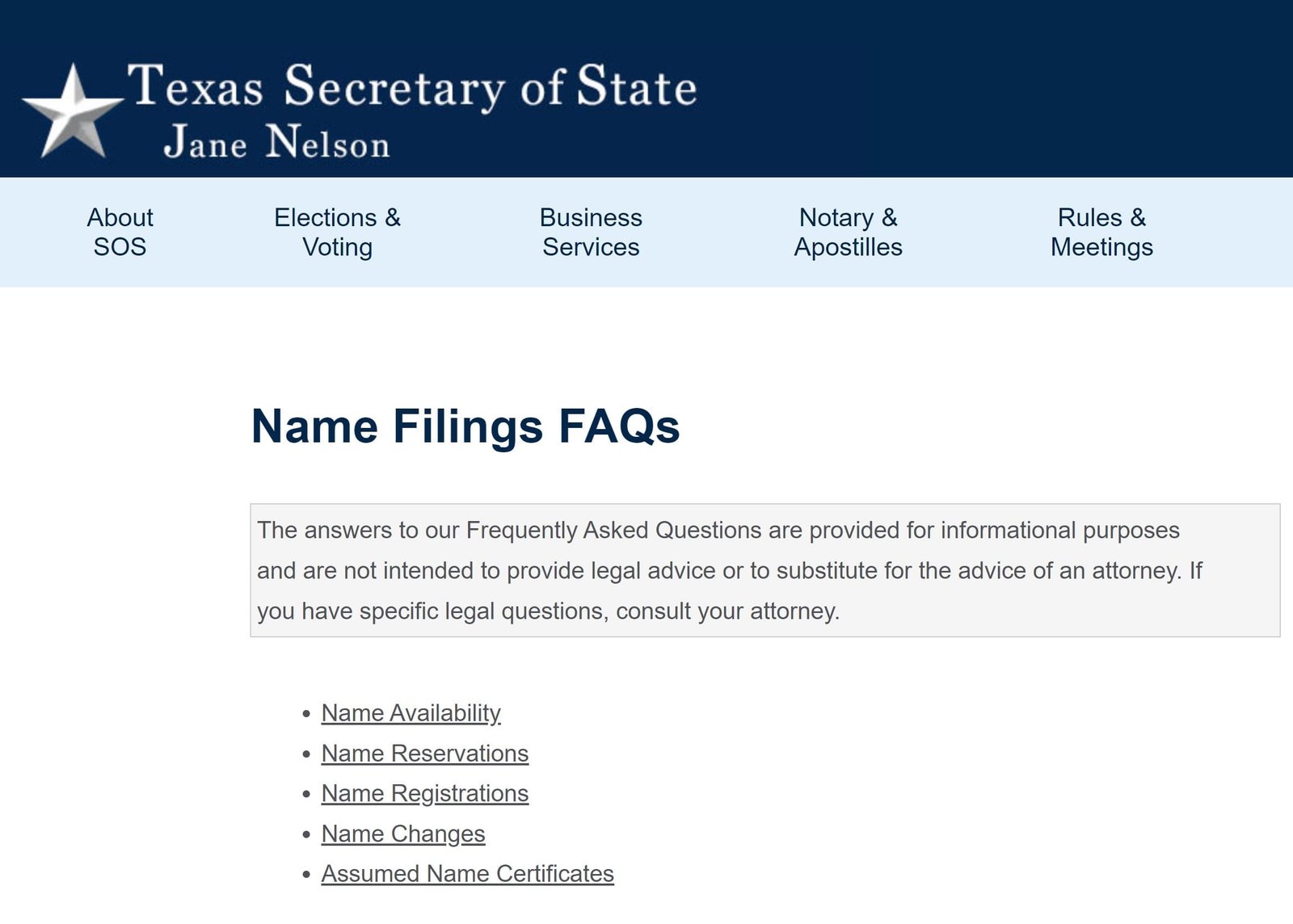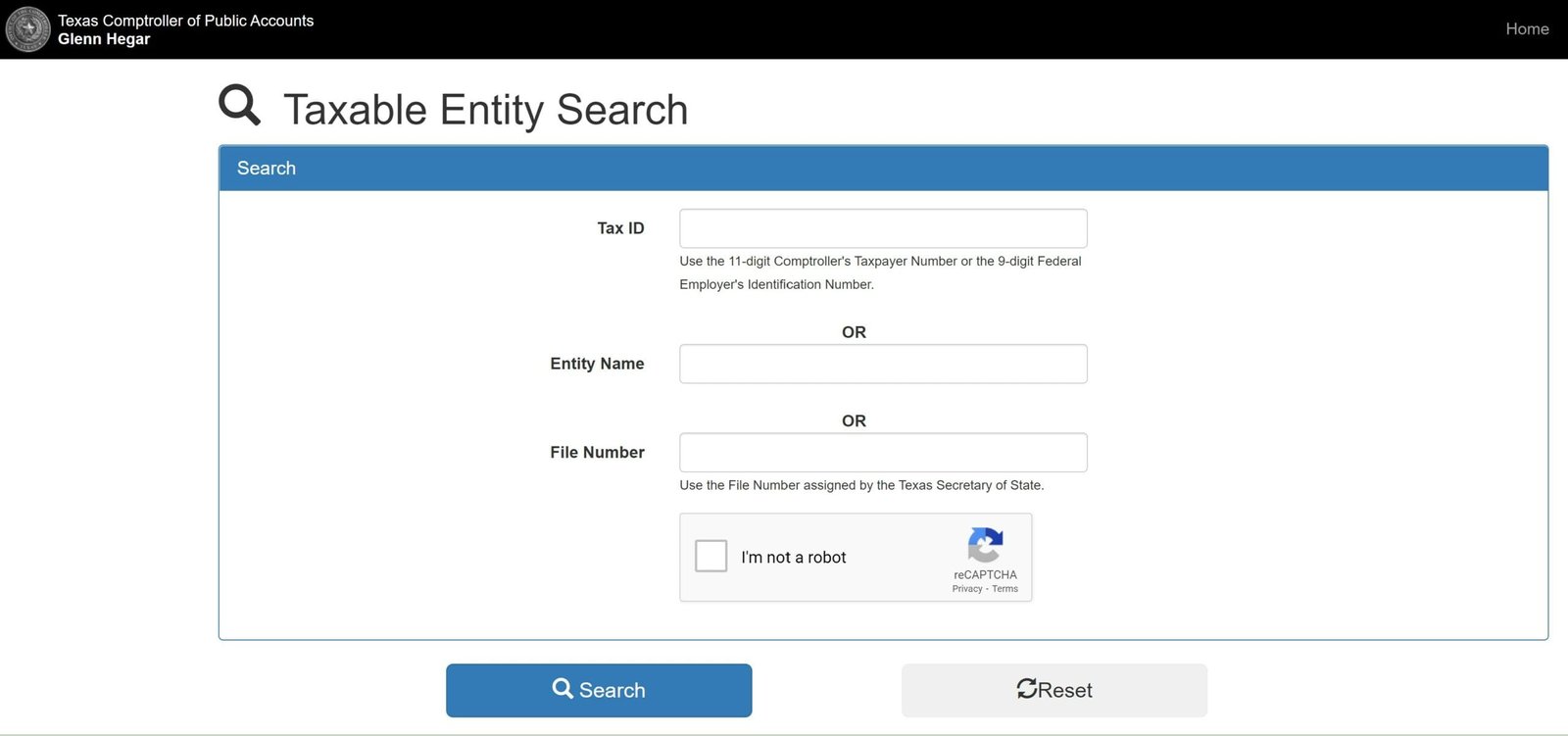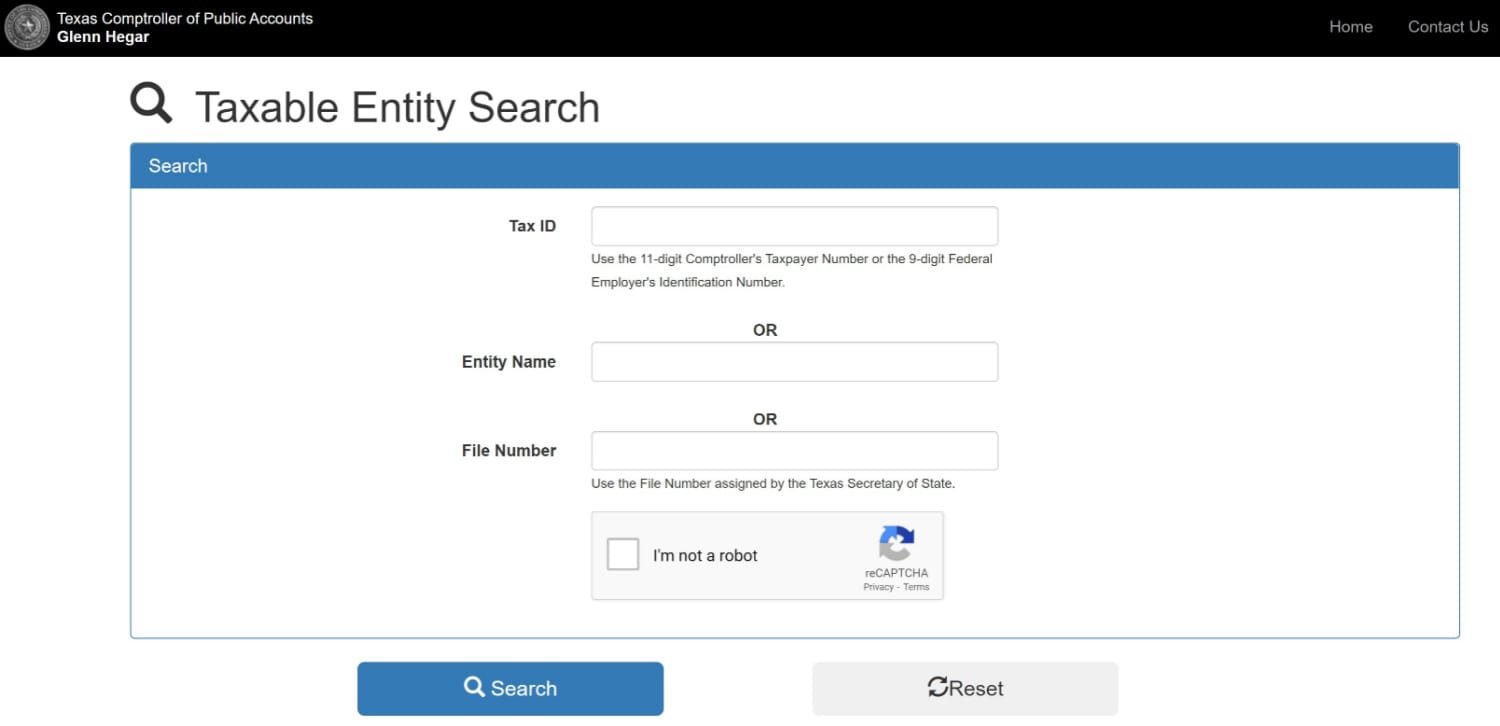A Texas LLC name search is quick and easy. Learn how to look up an LLC in Texas with a Texas business name search on the Texas Comptroller’s website.
Texas LLC Name Availability Search (Guide)

To look up an LLC name availability in the state of Texas, you can follow these steps:
- Go to the Texas Taxable Entity Search or you can search the Texas Secretary of State’s website database tool, SOSDirect for $1.00 per search. SOSDirect is an online business service from the Texas Secretary of State.
- Click on the “Business & Filings” tab in the top menu.
- Select “Search Business Filings” from the dropdown menu.
- Choose “Search by Name” or “Search by File Number” to enter the LLC’s name or file number.
- Enter the LLC’s name or file number in the search field and click “Search.”
- The search results will display the LLC’s name, status, and registered agent information.
Note that the search results will only show LLCs that are registered with the Texas Secretary of State. If the LLC is not registered or has not filed its required paperwork, it may not appear in the search results.
Texas Secretary of State | Contact Information
Mailing Address
Business & Commercial Section
Texas Secretary of State
P.O. Box 13697
Austin, TX 78711-3697
Physical Address
1019 Brazos St.
Austin, TX 78701
Hours: Monday–Friday, 8:00 a.m.–5:00 p.m.
Email: Corpinfo@sos.texas.gov
Phone: (512) 463-5555
What is a Texas Business Entity?

A Texas business entity refers to an organization that is formed and registered to conduct business in the state of Texas. As with other states, Texas recognizes several different types of business entities, each with its own set of rules, regulations, tax obligations, and liability structures.
These entities are governed by Texas state law and must be registered with the Texas Secretary of State’s office.
Here are some common types of business entities in Texas:
- Sole Proprietorship: This is a business owned by a single individual. It’s the simplest form of business entity, but the owner is personally liable for all business debts and obligations.
- Partnership: This includes general partnerships (GP), limited partnerships (LP), and limited liability partnerships (LLP). The liability and management structure differs between each type of partnership.
- Corporation: This is a separate legal entity owned by shareholders. Corporations provide liability protection to its owners and can be either a for-profit corporation (like a C corporation or S corporation) or a nonprofit corporation.
- Limited Liability Company (LLC): This is a hybrid structure that provides the limited liability features of a corporation and the tax efficiencies and operational flexibility of a partnership.
- Professional entities: These include professional associations (PA), professional corporations (PC), professional limited liability companies (PLLC), and other entities designed for licensed professionals like doctors, lawyers, accountants, architects, etc.
Texas Secretary of State Business Entity Name Search

To form a business entity in Texas, you typically need to file the appropriate formation documents (like Articles of Incorporation for corporations or Certificate of Formation for LLCs) with the Texas Secretary of State and pay any associated filing fees.
Can I Reserve a Business Name Online?
Yes. You can file a name reservation through the Texas Secretary of State’s SOSDirect 24 hours a day, 7 days a week.

Texas Name Filings FAQs

Search Business Name Availability in Texas (Texas LLC Lookup Guide)
| Texas Name LLC Search – Texas Comptroller Website https://mycpa.cpa.state.tx.us/coa/ |

Choose a name for your business entity
Your business’s brand name will be part of its identity. It doesn’t make a difference if the business is an LLC/corporation, but a memorable name is what people will associate you with. Also, make sure your name is catchy and memorable.
How to find a great business name
It’s not hard to understand that you need a business name. The process of coming up with a name is quite different. This is where you should sit down and consider different naming options.
This is the most effective way to achieve this goal, though it will likely take some time.
Texas Naming Guidelines
1. Texas’s rules regarding business names
Before you pick a name for your business, read the Texas business naming rules. These rules are quite strict, and it is crucial to review them before making a list. Your Certificate of Formation with the Texas Secretary of State (SOS), can be denied if your proposed name does not conform to these rules.
The Rules
Texas has many rules for business naming. You can find them on the website Secretary of State. The following requirements must be met in general
- The business entity name must stand out from other names.
- The name does not have to imply affiliation with a government agency.
- The name cannot mean it will engage in illegal acts.
- If the name is to be used in a prohibited manner, such words as “university,” “bank”, or “bank”, it must comply with certain conditions.
- Names can not be grossly offensive.
A complete list can be found in Title I, Part 4 – Chapter 1979 – Subchapter C (“Entity Names”) of the Texas Administrative Code.
2. Perform a Texas business entity name availability search
Search Texas businesses: Search for LLC or corporation names. Texas has an easy way for you to do it on their website.
How to conduct a corporation lookup or LLC lookup

Texas LLC Name Search Link https://mycpa.cpa.state.tx.us/coa/
To perform a Texas business name lookup, you must first go to the Texas Comptroller’s Website. Search for “taxable entity lookup” on the website. It will take you to the search engine that allows you to search for all taxable entities throughout Texas. This tool will help you determine if your desired business name is available.
This tool is free, and you don’t even need an account. Just enter your potential name into the “EntityName” box. This will let you see if there is an existing business that uses your name.
SOS Texas business search
Check LLC name availability. SOS is another option. TX has limited business search options. If you want extra assurance that your potential company name is available even though the search tool indicates it, contact the SOS via phone at (512), 463-5555.
Search business names. These are the two most effective ways to search Texas for businesses. Websites of the Secretary of State and agencies from other states (depending on which state they are) provide a business search tool. You might also want to explore other states.
Texas Name Search in Spanish of Other Languages
The Texas business name search is in English only, but you can use Google Translate, or a Chrome extension for name translations. You can also contact the Texas Secretary of State office by phone at (512), 463-5555 and request a Spanish speaking clerk for assistance.
3. Choose a domain
Next, pick a domain name closely matching your Texas business. You can now get a domain by performing a corporation/LLC lookup. It’s not necessary to have a domain address unless you intend to establish an online business. It doesn’t matter what; now is the time for domain names.
4. Texas Business Name Reservation
The last step is registering Texas business names with the Secretary of state. File Form 501 General Information (Application of Reservation or Renewal of Reservation of Entity Name) This form allows you to reserve a business name for a corporation, LLC, or other entity.
Fill out Form 501
The Instructions for Filling Form 501 Included are some helpful tips. The information section is short. The following information must be included:
- Name of the entity to be reserved
- Which type of entity do you want to form? LLC, corporation, etc.
- Your name and address
- Your signature
Your name will be held for 120 consecutive days.
Texas: You can get an assumed surname
Business entity. In addition to a business name, you can also obtain an assumed name. While your company name can be used to do business, an assumed or “doing Business as Name” name will allow you to use a different name.
Texas Business Tips
When you’re looking to form an LLC in Texas, conducting a Texas LLC name search is crucial to ensure that your desired business name is available and compliant with the state’s requirements.
Once you’ve confirmed name availability, you can proceed with the formation process and get your Texas business name registered.
Drafting a Texas LLC operating agreement is highly recommended to establish the internal rules and regulations of your LLC. You have the option to act as your own registered agent in Texas, handling the receipt of important legal and tax documents on behalf of your LLC.
The length of time to get an LLC in Texas may vary based on several factors, including the filing method and the workload of the Texas Secretary of State. It typically takes around 2-3 weeks for the formation documents to be processed and the LLC to be officially recognized.
As part of the process, you will need to obtain an Employer Identification Number (EIN) for your TExas business from the Internal Revenue Service (IRS). This unique identifier is necessary for tax purposes, opening bank accounts, and hiring employees.
Several online platforms and registered agents offer comprehensive LLC services, including name availability searches, document preparation, and filing assistance. Researching and selecting the best LLC services and registered agents in Texas can help streamline the formation process and ensure compliance with state regulations.
Additionally, depending on the nature of your business activities, you may need to acquire specific Texas business licenses at the state or local level. The cost to form an LLC in Texas typically includes filing fees and any additional expenses related to name reservation, certified copies, or expedited processing. The cost is the same even for a single-member LLC in Texas.
Lastly, if you ever decide to change your registered agent or dissolve and close your LLC in Texas, there are specific legal requirements and procedures that must be followed to formally terminate the entity.
Texas Business Entity Name Search FAQs
- What is the purpose of a business entity name search in Texas? Conducting a business entity name search in Texas is essential to ensure the name you want for your business is not already in use or too similar to existing entity names. This is a crucial step in forming a new business, as Texas law requires each business entity to have a distinct name for legal and identification purposes.
- How can I conduct a business entity name search in Texas? You can search for business entity names through the Texas Comptroller of Public Accounts website or the Texas Secretary of State’s SOSDirect website. These online databases allow you to search and verify if a business name is currently in use or has significant similarities to existing names.
- Is there a fee associated with searching for a business name in Texas? Typically, there is no fee for conducting a basic name availability search through the Texas Secretary of State’s online resources. However, if you require more in-depth information or official documentation, there may be a fee for these services.
- What should I do if the business name I want is already taken in Texas? If your desired business name is unavailable, you will need to modify it or choose a different name that is unique and compliant with Texas naming regulations. It’s beneficial to have alternative names in mind before starting the search process.
- Can I reserve a business name in Texas before forming my entity? Yes, you can reserve a business name for a specific period (usually 120 days) by filing an application with the Texas Secretary of State and paying the applicable reservation fee. This reserves the name exclusively for your use during that period.
- Are there any naming restrictions for businesses in Texas? Texas has specific guidelines for business names. For example, names must be distinguishable from existing entities and cannot imply association with government agencies. Certain words may require additional documentation or licenses to use (e.g., “bank,” “university”).
- How can I ensure my chosen business name complies with Texas law? To ensure compliance, review the Texas business naming guidelines available on the Secretary of State’s website. It’s also advisable to consult with a legal professional, especially if your desired name includes words that might have regulatory restrictions.
- What are the next steps after finding an available business name in Texas? Once you find an available name, you can reserve it if you’re not ready to form your business entity immediately. The next step is to formally register your business with the Texas Secretary of State by filing the necessary formation documents under the chosen name.
- Can I use a ‘Doing Business As’ (DBA) name in Texas? Yes, you can operate under a DBA name in Texas. However, you must ensure that the DBA name is also unique and file a DBA registration with the county clerk’s office where your business is located.
- How often is the Texas business name database updated? The Texas business name database is regularly updated, though the exact frequency can vary. For the most current information, it’s best to check directly with the Texas Secretary of State or the Comptroller’s office.
Texas LLC Name Search: Additional Steps and Considerations
1. Trademark Search

When searching for a business name, it’s important to note that availability doesn’t necessarily mean the name is free to use if it’s already a registered trademark.
To avoid potential complications down the line, it’s wise to conduct a thorough trademark search using the Trademark Electronic Search System before finalizing a business name.
2. Check if the Domain Name is Available
To check if a domain name is available, you can follow these steps:
- Go to a domain registrar website, such as GoDaddy.com or Namecheap.com.
- In the search bar on the homepage, type in the domain name you want to check.
Additionally, if you are considering registering a domain name for your business, make sure to also check for any existing trademarks that may conflict with your chosen domain name.
3. Check if Social Media Name is Available
Check if a social media name is available for your new business name.
4. Register Texas Business Entity
When you complete the required documents for filing a new business entity, you then register your business and business name with the state. The state of Texas will either approve your business name or reject it.
If you hire a good LLC service like Northwest Registered Agent, ZenBusiness or Bizee, these LLC services have business name tools available for you to do a quick search. I recommend using any of these 3 services to assist you with forming a new business. They can save you time and provide you with guidance through the formation process.
Additional Texas LLC Name Search – FAQs
How do I get an assumed name?
To register an assumed surname, you must file Form 503 General Information (Assumed Name Certificate) with the Secretary of State. This form can be found at the SOS’s website.
Why would I need an assumed identity?
An assumed name may be used if your current business name doesn’t reflect your new product launch. For opening a new shop, an assumed name can be used. Depending on the entity formed, there will be different reasons for an assumed name.
Can I renew the Texas business name reservation for my company?
Yes. It is possible to renew your business name reservation. Form 501 can be filed within the 30-day time period prior to the expiration of the reservation.
What is the best way to change my Texas business’s name?
For your business to change its name, you must file Form 424 – General Information – Certificate of Amendment with the Secretary. Be aware that the name you would like to change cannot already be used in another business. You will need to search for another LLC name or corporation. The state of Texas has a few options for doing this.
Can I change the business name online?
Yes. You can submit Form 424, online through the SOSDirect section of the Secretary o State’s website.
What business types are required to file an Assumed Name Certificate?
If you’re planning on doing business under an assumed identity, then the following entities should file an assumed names certificate:
- LLCs, including professional limited liability company (PLLC),
- Corporations (nonprofits, for-profits, and professionals)
- Limited liability partnerships (“LLPs”)
- Limited Partnerships (LPs).
- Professional associations
- Foreign filing entities
Can I name my LLC after myself?
Yes, your LLC can be named after you. However, this should be considered from a professional marketing and professional standpoint. Are you able to generate interest in the brand with your name? Is it catchy? If you want to do business as someone else, you can always get an assumed title.
How can I find an LLC in Texas?
Using the Texas database search, you can search for the business name, business entity number, or executive name. For a business entity to exist, all this information must be registered with the state.
How do I confirm that a Texas company is registered?
You can search for the company’s name, entity number, or executive name by searching the state. You can search by the name, entity number, or executive name if you don’t find it in Texas.



The guide to DBA registration in Texas was a great addition to LLC name search. It’s an essential step for businesses operating under a name different from their legal entity name.
Thanks Francisco
Highlighting the importance of a trademark search in Texas alongside the business name search is invaluable advice. It ensures that the name is not only available but also free from trademark issues.
Thanks Neil
The tips on navigating the Texas business entity search database were spot-on. It’s a crucial step in ensuring your chosen LLC name is unique and compliant with state laws.
Thanks Alex
I appreciated the detailed explanation of Texas’s naming guidelines. Understanding the legal name requirements and name distinguishability criteria is crucial for any new business starting in Texas.
Thanks Dean
The emphasis on using the Texas Secretary of State’s entity search tools was incredibly helpful. It’s great to see a guide that simplifies the name availability check process for Texas businesses.
Thanks Kristpher
I appreciate the straightforward approach in your blog post, Brian. It’s refreshing to find a concise guide on searching for a business entity name in Texas.
Thanks Brook
Hi Brian, I liked this guide on searching for available business names in Texas. I appreciated the step-by-step process outlined, as well as the emphasis on conducting a thorough search to avoid potential legal issues.
One key takeaway for me was the importance of checking domain name availability alongside the business name.
Brian, have you ever encountered situations where domain name availability affected the selection of a business name?
Hi Elizabeth,
I haven’t personally encountered situations where domain name availability affected the selection of a business name. However, it is quite common for businesses, especially in today’s digital age, to consider domain name availability as a crucial factor when choosing a business name. If a business name is not available as a domain name or if a similar domain name is already in use, it can impact the brand’s online presence, search engine optimization, and overall digital marketing strategy. T
Thank you, Brian, for sharing this insightful article on searching for available business names in Texas. Your emphasis on conducting a thorough search and considering variations in spelling and abbreviations is crucial. I particularly appreciated your suggestion to search social media platforms as well. It made me wonder, have you come across situations where businesses faced branding or trademark conflicts due to similar social media handles?
Hi, Heather,
Yes, businesses can indeed face branding or trademark conflicts due to similar social media handles when searching for the availability of a business name. Social media platforms have become integral to brand building and marketing strategies for businesses. Having a consistent and recognizable social media presence is crucial in today’s digital landscape.
This is just what I needed, Brian! Your step-by-step instructions on searching a business entity name online in Texas are clear and easy.
Thanks Justin
Brian, your article on searching for available business names in Texas is incredibly informative. I found your tips on conducting a search through the Texas Secretary of State website and the U.S. Patent and Trademark Office particularly helpful.
One key takeaway for me was the reminder to consider future expansion and the potential impact of geographical limitations.
Have you ever encountered challenges with business name selection due to geographic restrictions?
Kevin
Hi Kevin,
I don’t have personal experiences, but I can provide some insights. When searching for a business name, entrepreneurs can sometimes face challenges with business name selection due to geographic restrictions. These restrictions can arise from local laws or regulations that prohibit certain names or require specific naming conventions based on the location.
Hi Brian,
As an entrepreneur considering starting a business in Texas, I found this article to be a valuable resource. The step-by-step process of conducting a business name search is well-explained and practical.
The key takeaway of being thorough and checking for trademark registrations is crucial. This article has provided me with a clear roadmap for ensuring my business name is available and legally sound.
Thanks Andrew